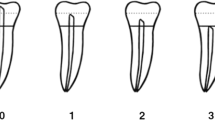Abstract
The aim of the present paper was to improve and expand research with a larger number of children from various European countries and to provide a common formula useful for all these countries. Orthopantomographs taken from 2,652 European Caucasian children (1,382 boys, 1,270 girls) aged between 4 and 16 years were analyzed. The children came from Croatia, Germany, Kosovo, Italy, Slovenia, Spain, and the UK. Following the pilot study, subjects’ age was modeled as a function of gender (g), morphological variables (predictors) × 5(second premolar), s (sum of normalized open apices) N 0, and the first-order interaction between s and N 0. The results showed that all these variables contributed significantly to the fit, so that all were included in the regression model, yielding the following linear regression formula: Age = 8.387 + 0.282 g − 1.692 × 5 + 0.835 N 0 − 0.116 s − 0.139 s × N 0, where g is a variable, 1 for males and 0 for females. The equation explained 86.1% (R 2 = 0.861) of total deviance. The median of the residuals (=observed age minus predicted age) was −0.114 years, with (RefB.2) interquartile range = 1.22 years.

Similar content being viewed by others
References
Saunders E (1837) The teeth: a test of age considered with reference to the factory children. Renshaw Strand, London
Demirjian A, Goldstein H, Tanner JH (1973) A new system of dental age assessment. Hum Biol 45:221–227
Koshy S, Tandon S (1998) Dental age assessment: the applicability of Demirjian’s method in south Indian children. Forensic Sci Int 94:73–85
Nykanen R, Espeland L, Kvaal SI, Krogstad O (1998) Validity of the Demirjian method for dental age estimation when applied to Norwegian children. Acta Odontol Scand 56:238–244
Liversidge HM, Speechly T, Hector MP (1999) Dental maturation in British children: are Demirjian’s standards applicable? Int J Paediatr Dent 9:263–269
Prabhakar AR, Panda AK, Raju OS (2002) Applicability of Demirjian’s method of age assessment in children of Davangere. J Indian Soc Pedod Prev Dent 20:54–62
Eid RM, Simi R, Friggi MN, Fisberg M (2002) Assessment of dental maturity of Brazilian children aged 6 to 14 years using Demirjian’s method. Int J Paediatr Dent 12:423–428
Chaillet N, Willems G, Demirjian A (2004) Dental maturity in Belgian children using Demirjian’s method and polynomial functions: new standard curves for forensic and clinical use. J Forensic Odonto Stomatol 22:18–27
Chaillet N, Demirjian A (2004) Dental maturity in south France: a comparison between Demirjian’s method and polynomial functions. J Forensic Sci 49:1059–1066
Chaillet N, Nystrom M, Demirjian A (2005) Comparison of dental maturity in children of different ethnic origins: international maturity curves for clinicians. J Forensic Sci 50:1164–1174
Cameriere R, Ferrante L, Cingolani M (2006) Age estimation in children by measurement of open apices in teeth. Int J Legal Med 120:49–52
Cameriere R, Ferrante L, Scarpino F, Branko E, Betjtulla Z (2006) Dental age estimation of growing children: comparison among various European countries. Acta Stomatol Croat 40:255–262
Eveleth PB, Tanner JM (1990) Worldwide variation in human growth, edn. Cambridge Univ. Press, Cambridge, pp 6–7
Mühler M, Schulz R, Schmidt S, Schmeling A, Reisinger W (2006) The influence of slice thickness on assessment of clavicle ossification in forensic age diagnostics. Int J Legal Med 120:15–17
Schmeling A, Baumann U, Schmidt S, Wernecke KD, Reisinger W (2006) Reference data for the Thiemann–Nitz method of assessing skeletal age for the purpose of forensic age estimation. Int J Legal Med 120:1–4
Cameriere R, Ferrante L, Mirtella D, Cingolani M (2006) Carpals and epiphyses of radius and ulna as age indicators. Int J Legal Med 120:143–146
Olze A, Bilang D, Schmidt S, Wernecke KD, Geserick G, Schmeling A (2005) Validation of common classification systems for assessing the mineralization of third molars. Int J Legal Med 119:22–26
Paewinsky E, Pfeiffer H, Brinkmann B (2005) Quantification of secondary dentine formation from orthopantomograms—a contribution to forensic age estimation methods in adults. Int J Legal Med 119:27–30
Nolla CM (1960) The development of the permanent teeth. J Dent Child 27:254–266
Haavikko K (1974) Tooth formation age estimated on a few selected teeth. A simple method for clinical use. Proc Finn Dent Soc 70:15–19
Acknowledgements
The authors would like to thank the Bejtulla Zeqiri Department of Orthodontics, University of Prishtina, Kosovo; José L. Prieto, Laboratorio de Antropología y Odontología Forense, Instituto Anatómico Forense, Madrid, Spain; Hrvoje Brkic, School of Dental Medicine, Department of Dental Anthropology, University of Zagreb, Croatia; Brita Willershausen and Ioannis Moschos, Poliklinik für Zahnerhaltungskunde, Klinikum der Johannes Gutenberg, Universität Mainz, Germany; Branko Eremenc, Institute of Forensic Medicine, Faculty of Medicine, University of Ljubljana, Slovenia; and Helen M. Liversidge, Dental Institute, Bart’s and The London School of Medicine and Dentistry, London, UK, who kindly supplied sample data from their respective countries.
Author information
Authors and Affiliations
Corresponding author
Rights and permissions
About this article
Cite this article
Cameriere, R., De Angelis, D., Ferrante, L. et al. Age estimation in children by measurement of open apices in teeth: a European formula. Int J Legal Med 121, 449–453 (2007). https://doi.org/10.1007/s00414-007-0179-1
Received:
Accepted:
Published:
Issue Date:
DOI: https://doi.org/10.1007/s00414-007-0179-1




